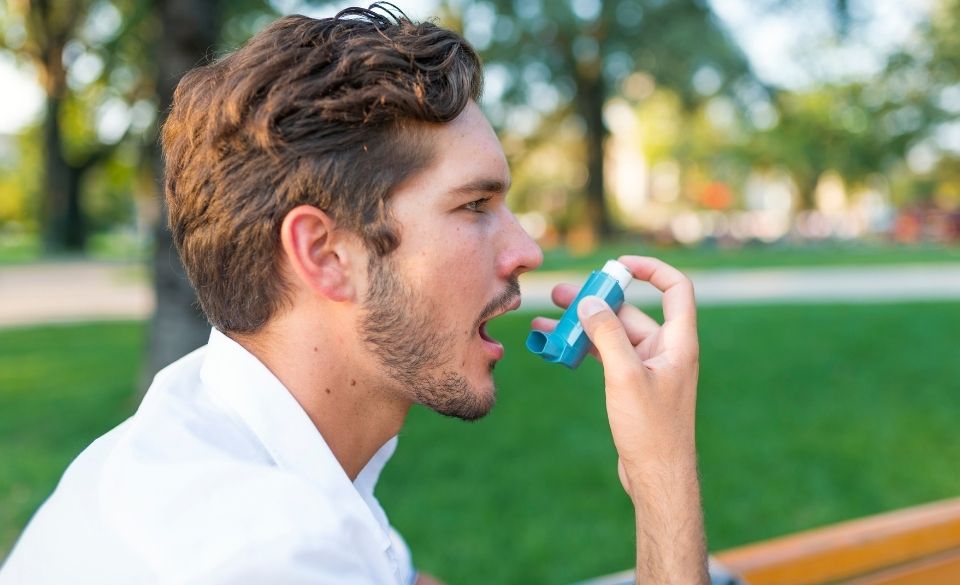
How To Run With Asthma? Complete Guide to Exercise-Induced Asthma
Page Contents
It’s no secret that many people deal with asthma daily. This includes runners and other sportspeople too. Asthma can be tricky as it cause difficulty breathing, coughing, tightness in the chest, and wheezing.
So, how can you run with asthma properly?
In this article, we discuss how you can run safely with asthma, and how you can get rid of asthma when running.
So, keep reading to find out more.
Exercise-Induced Asthma – What is it?
You may have heard of exercise-induced asthma, or even experienced it. However, some people have never heard of the term.
Exercise-induced asthma is a narrowing of the airways. It is usually caused by strenuous activity or exercise. When you experience exercise-induced asthma, the airways in your lungs will then narrow, causing coughing, tightness in the chest, and other symptoms.
However, most people that experience exercise-induced asthma can continue to exercise. They can remain active by treating the symptoms correctly. This is usually through medications or preventive measures.
If you are unsure of whether you are experienced exercise-induced asthma, below are the most common symptoms you will experience.
– Coughing
– Wheezing
– Shortness of breath
– Chest tightness
– Fatigue when running or exercising
– A decline in athletic performance
While there are sometimes other symptoms that may appear when running or doing another form of exercise. These are the most common symptoms people experience.

What Does It Feel Like To Run With Asthma?
If you haven’t experienced exercise-induced asthma before, you are probably wondering what does it feel like to run with asthma.
Running with asthma can be difficult. The narrowing of your airways and other physiological responses can make it hard enough for air to get into your airways. This can prevent you from providing enough oxygen to the muscles, slow your pace down and make running uncomfortable.
Chest tightness, wheezing, and shortness of breath can all affect your running, which can sometimes cause you to stop multiple times on a run or even prevent you from running altogether.
However, you will be happy to know it is still possible to run safely with asthma. If done right, running can help to reduce the symptoms by strengthening the lungs and reducing inflammation.
For most people, exercise-induced asthma won’t go away completely. It is a condition that needs to be controlled and treated. However, children are a little luckier and can outgrow it sometimes.
How to Run With Asthma?
Even if you deal with asthma, it is still possible to run safely. Knowing how to run with asthma is the key to enjoying running safely.
However, if you are new to running and struggle with asthma, running can help relieve symptoms. A study in 2018 found that physical activity can help improve lung function in people that have asthma, as it slows down the decline in lung function.
So, how do you run with asthma?
First, start by understanding your symptoms. Then talk to your doctor about preventive measures to control these.
After that, your doctor will help you put together an asthma action plan. This may include regular use of an inhaler to soothe your airways and reduce inflammation. Your doctor may prescribe the use of an inhaler 15 minutes before heading out running.
Secondly, it is important to pay attention to your body. Before, during, and after running. That means making sure you are familiar with typical signs of exercising such as:
– Flushed skin
– Faster, deeper breathing
– Increased sweating rate
– Increased temperature
– Increased heart rate
Then it is vital to know the signs and symptoms of an asthma attack. These aren’t normal during exercise and may include:
– Coughing
– Wheezing
– Shortness of breath
– Chest tightness
– Heavy breathing that doesn’t slow down
Thirdly, you will need to carry your rescue inhaler with you. It can help to prevent an asthma attack and reduce symptoms quickly.

How Do You Get Rid Of Asthma When Running?
Generally, asthma symptoms (wheezing, coughing, and shortness of breath) peak within the first 10 to 15 minutes of running. Then most people find it usually resolves by the 60-minute mark.
So, it is important to warm up correctly before settling into your workout or normal running pace. Doing so will help your airways adjust to the need for increased airflow.
However, if the weather is cold try covering your mouth with a scarf or something similar. This will help warmer air pass through the airways. If you struggle to run with something covering your mouth, try using an AirTrim which can change the air temperature going into your airways.
Alternatively, use asthma medications. Medications like albuterol can prevent airway spasms during your run. Just make sure you take some 15-20 minutes before you head out running.
People that experience stronger asthma symptoms may require the use of a long-acting bronchodilator. These generally work for around 12 hours and can help prevent asthma symptoms. Before, during, and after running.
How to Run With Asthma – Conclusion
Just because you have asthma or exercise-induced asthma, doesn’t mean you can’t exercise or run. You will just need to take some precautionary measures to prevent symptoms from showing up when running.
By following the precautionary measures in this article, as well as advice from your doctor. You should be able to train as normal.
However, remember to warm up and down correctly during and after running. It will help open the airways and reduce the chances of asthma symptoms appearing during and after a run.



